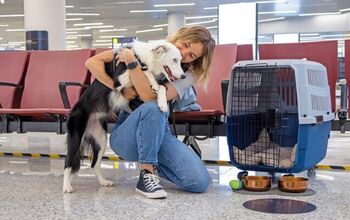Flying with pets can be stressful, from navigating security screening and busy airports to keeping your pet safe and settled on the flight. But Shenzhen Bao’an International Airport in China has decided that it’s time to make some changes to pet-friendly travel.After recognizing that a growing number of pets are traveling through the airport, it was decided that there was a demand for pet-specific accommodations. As a result, they created the first pet waiting lounge in the country, offering a comfortable place for pets to wait during layovers, flight delays, or unexpected cancellations.The lounge features 24-hour surveillance, temperature and humidity monitoring with alerts, and location tracking. It is regularly staffed and patrolled by pet specialists and offers both on-demand feeding and remote medical services as needed.The facility is approximately 2260 square feet (210 square meters) and was designed with pets in mind. It offers separate dog and cat zones, a pet entertainment area, and dedicated waiting spaces.“Pets are often treated as ‘live cargo’ in air transport, but the ‘furry children’ have already become members of many families,” explained Zhou Jie, general manager of Shenzen Airport Domestic Cargo Terminal. “The establishment of the pet lounge has changed the mode of mixed transport of pets and air cargo in the past. Based on the digital platform and internet of things technology, a remote medical diagnosis system and epidemic prevention measures have been introduced to provide pets with foster care, nursing, and other services to ensure their safety and comfort.”While this is the first pet-specific lounge in China, it’s not the first to be built worldwide. Several other airports have created specialized services to care for pets traveling through their doors or are near pet-focused accommodations.Directly next to Los Angeles International Airport, Kennel Club LAX provides luxury amenities for pet visitors, including a high-end pet hotel, grooming, spa treatments, training, a play area, and other activities to ensure that furry travelers enjoy the best possible experience during their stay. Soothing music helps to create a relaxing environment, and a dedicated free shuttle will ensure your pet doesn’t miss their flight.Another US-based example is the ARK at John F Kennedy Airport in Queens, New York. Unlike Kennel Club LAX, the ARK is airport-owned and operated – the only such facility currently operating in the country.In addition to dog and cat zones, the ARK offers care for horses, birds, and livestock. The ARK Pet Oasis, dedicated to caring for companion animals, features spacious kennels with 24-hour observation. Pets are provided with food, water, crate cleaning, opportunities for outdoor relief, and, if you choose to add the service, a bath. They are also uniquely qualified to assist with U.S. Customs Clearance.A USDA Level II certified veterinarian is on-site to provide care in the event of illness or emergency. When required, pets can be transported off-site to a nearby veterinary hospital.Dedicated pet lounges and facilities like those listed here are the exception. However, travel-loving pet parents across the country and worldwide can celebrate the fact that new accommodations continue to be developed and opened for pet travelers. We look forward to a pet-friendly future at airports everywhere!Join the PetGuide community. Get the latest pet news and product recommendations by subscribing to our newsletter here.












